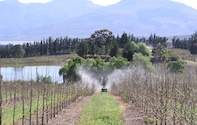Bud Mite
Bud mite is microscopically small worm-like organisms that is spread through wind, birds and contaminated plant material. They are hard to see without enlargement and lies dormant in winter inside the buds.

The three types of mites that occur in vineyards are the bud mite, leaf curl mite and erinose mite, of which the bud mite causes the greatest damage.
Especially Hanepoot and Cabernet Sauvignon are sensitive to bud mite. Symptoms include a zig-zag growth pattern, deformed grape bunches and shortened internodes and uneven bud burst.
Some of the symptoms can also be confused with mineral deficiencies, hence microscopic investigations must be done to confirm the presence of bud mites. In case of heavy contamination, there will be no bud break but if there are budding, the leaves or grape clusters may be damaged.
Chemical control to protect the next year’s crop should only be applied after bud break when the insects move towards the new growth. The timing is important as the mites leave the buds only for a short while. Just after bud break, when the shoots are about 10 to 15 cm long, spray it thoroughly with a registered pesticide. It should be repeated 14 days later.